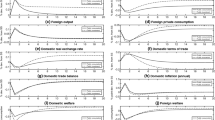Abstract
The cost of public investment is not the increment to the value ofpublic capital. Unlike with private investors, there is no plausiblebehavioral model in which every dollar that the public sectorspends as ``investment'' creates economically valuable ``capital.''While this simple analytic point is obvious, it has so far beenuniformly ignored in the empirical literature on economic growth,which uses—at best—cumulated, depreciated, investmenteffort (CUDIE) as a proxy for capital stocks. However, particularlyfor developing countries the difference between investment costand capital value is of first-order empirical importance: governmentinvestment is half of more of total investment, and calculationspresented here suggest that in many countries government investmentspending has created little useful capital. This has implicationsin three broad areas. First, none of the existing empirical estimatesof the impact of public spending has identified the productivityof public capital. Even where public capital has a potentiallylarge contribution to production, public-investment spendingmay have had a low impact. Second, it implies that all estimatesof total factor productivity in developing countries are deeplysuspect as there is no way to empirically distinguish betweenlow growth because of investments that create no factors andlow growth due to slow productivity growth. Third, multivariateregressions to date have not adequately controlled for capitalstock growth, which leads to erroneous interpretations of regressioncoefficients.
Similar content being viewed by others
References
Aschauer, David. (1989). “Is Public Expenditure Productive?” Journal of Monetary Economics 23, 177-200.
Benhabib, Jess, and Mark Spiegel. (1994). “Role of Human Capital in Economic Development: Evidence from Aggregate Cross-Country Data.” Journal of Monetary Economics 34, 143-173.
Bernard, Andrew B., and Charles I. Jones. (1996). “Technology and Convergence.” Economic Journal 106, 1037-1044.
Boskin, Michael, J., Marc Robinson, and John M. Roberts. (1985). “New Estimate of Government Tangible Capital and Net Investment.” NBER Working Paper Series No. 1774.
Bosworth, Barry, Susan Collins, and Yu-chin Chen. (1995). “Accounting for Differences in Economic Growth.” Mimeo, Brookings.
Boycko, Maxim, Andrei Shliefer, and Robert Vishny. (1993). “Privatizing Russia.” Brookings Papers on Economic Activity 2, 139-192.
Campos, Edgardo, and Hilton Root. (1996). The Key to Asian Miracle: Making Shared Growth Credible. Washington, DC: Brookings.
Canning, David, and Marianne Fay. (1996). “Infrastructure and Growth.” Mimeo.
Charap, Joshua, and Christian Harm. (1999). “Institutionalized Corruption and the Kleptocratic State.” IMF Working Paper.
De Long, J. Bradford, and Lawrence H. Summerss (1992). “Equipment Investment and Economic Growth: How Strong Is the Nexus?” Brookings Papers on Economic Activity 2, 157-211.
Easterly, William (1999). “When Is Fiscal Adjustment an Illusion?” World Bank Policy ResearchWorking Paper No. 2109.
Easterly, William. (1999b). “The Ghost of Financing Gap: Testing the Growth Model Used in the International Financial Institutions.” Journal of Development Economics 60, 423-438.
Easterly, William, and Sergio Rebelo. (1993). “Fiscal Policy and Economic Growth: An Empirical Investigation.” Journal of Monetary Economics 32, 417-458.
Hall, Robert E. (1989). “Invariance Properties of Solow's Productivity Residual.” In Robert M. Solow and Peter Diamond. Growth, Productivity, Unemployment: Essays to Celebrate Bob Solow's Birthday. Cambridge, MA: MIT Press.
Hall, Robert E., and Charles Jones. (1999). “Why Do Some Countries Produce So Much More Output per Worker Than Others?” Quarterly Journal of Economics 114, 83-116.
Hayek, Friedrich A. (1941). The Pure Theory of Capital. Chicago: University of Chicago Press.
Holtz-Eakin, Douglas. (1992). “Public Sector Capital and the Productivity Puzzle.” NBER Working Paper No. 4122.
Hulten, Charles R. (1996). “Infrastructure Capital and Economic Growth: How Well You Use It May Be More Important Than How Much You Have.” NBER Working Paper No. 5847.
Isham, Jonathan, Daniel Kaufmann, and Lant Pritchett. (1996). “Governance and the Returns to Investment: An Empirical Investigation.” World Bank Policy Research Paper No. 1550.
Isham, Jonathan, Deepa Narayan, and Lant Pritchett. (1995). “Does Participation Improve Performance? Establishing Causality with Subjective Data.” World Bank Economic Review 9, 175-201.
Islam, Nazrul. (1995). “Growth Empirics: A Panel Data Approach.” Quarterly Journal of Economics 110, 1127-1170.
Jaffe, Adam. (1986). “Technological Opportunity and Spillovers of R&D: Evidence from Firms' Patents, Profits, and Market Value.” NBER Working Paper No. 1815.
Joshi, Vijay, and I.M.D. Little. (1994). India: Macroeconomics and Political Economy, 1964–1991. Washington, DC: World Bank.
Keefer, Philip, and Stephen Knack. (1997). “Why Don't Poor Countries Catch Up? A Cross-National Test of an Institutional Explanation.” Economic Inquiry (U.S) 35, 590-602.
King, Robert G., and Ross Levine. (1994). “Capital Fundamentalism, Economic Development, and Economic Growth.” Carnegie-Rochester Conference on Public Policy 40, 259-292.
Mauro, Paolo. (1998). “Corruption and the Composition of Government Expenditure.” Journal of Public Economics 69, 263-279.
Milgrom, Paul R., and John Roberts. (1992). Economics, Organization, and Management. Edgewood Cliffs, NJ: Prentice-Hall.
Nehru, Vikram, and Ashok Dhareshwar. (1993). “A New Database on Physical Capital Stock: Sources, Methodology and Results.” Revista de Analisis Economico 8, 37-59.
Osborne, David, and Ted Gaebler. (1992). Reinventing Government: How the Entrepreneurial Spirit is Transforming the Public Sector. New York: Plume, Penguin Books.
Pritchett, Lant. (1996). “Where Has All the Education Gone?” World Bank Policy Research Working Paper No. 1581.
Rajaiah, B. (1989). Returns to Investment and Efficiency in Public Enterprises in India. Delhi: Mittal.
Sachs, Jeffrey, and Andrew Warner. (1995). “Economic Reform and the Process of Global Integration.” Brookings Papers on Economic Activity 1, 1-118.
Shah, Anwar. (1992). “Dynamics of Public Infrastructure, Industrial Productivity, and Profitability.” Review of Economics and Statistics 74, 28-36.
Shleifer, Andrei. (1993). “Corruption.” Quarterly Journal of Economics 108, 599-617.
Shleifer, Andrei, and Robert W. Vishny. (1998). “The Grabbing Hand: Government Pathologies and Their Cures.” Cambridge, MA: Harvard University Press.
Uchimura, Kauko, and Jong Gao. (1993). “The Importance of Infrastructure on Economic Development.” World Bank, Latin American Regional Office, Washington, DC.
Author information
Authors and Affiliations
Rights and permissions
About this article
Cite this article
Pritchett, L. The Tyranny of Concepts: CUDIE (Cumulated, Depreciated, Investment Effort) Is Not Capital. Journal of Economic Growth 5, 361–384 (2000). https://doi.org/10.1023/A:1026551519329
Issue Date:
DOI: https://doi.org/10.1023/A:1026551519329




